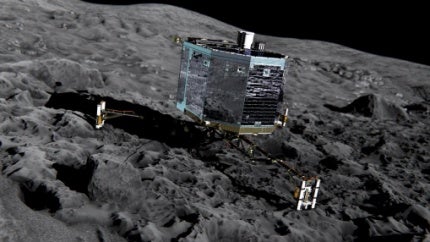
The European space probe Rosetta has reached the comet Chury, after more than ten years of travel through space. Three months from now, for the first time in the history of space travel, a lander, which uses maxon motor DC motors, will touch down on the surface of the 4km-wide comet.
On 6 August, the Rosetta space probe reached the comet 67P/Churyumov-Gerasimenko, known as ‘Chury’ for short. For the first time in the history of space travel, a probe has rendezvoused with a comet. It will now orbit and map the comet and gather various types of data.
The first images received have yielded astonishing new insights: the comet Chury, which is 4km wide, is not round or oval, but instead looks like two rocks loosely stuck together; at -70°C, the surface is much warmer than expected; and the first information indicates that the comet is covered with a black layer of dust.
Rosetta will now gradually approach the comet, until a distance of only 10km separates them. The most difficult part of the mission will take place in mid-November, when the Philae lander is scheduled to touch down on Chury. The lander has a maxon motor DC motor on-board.
First choice for space missions
SpaceX’s Dragon spacecraft, which transports cargo to the International Space Station (ISS), also contains maxon motors. The same holds true for the Mars rovers, which have been travelling across the surface of the red planet for many years.

